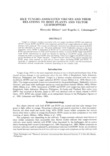Tungro is a disease complex associated with rice tungro bacilliform (RTBV) and spherical (RTSV) viruses. RTBV and RTSV were separately purified from tungro-affected rice plants and antisera were produced. The viruses are efficiently detected from infected rice leaves in ELISA and less efficiently by latex test. The green leafhopper (GLH) Nephotettix virescens is the most important vector. RTBV is dependent on RTSV for its transmission by GLH. Both RTBV and RTSV are semi-persistent in GLH. GLH retained the ability to acquire RTBV longer than RTSV itself. RTSV transmission by GLH was blocked by feeding on anti-RTSV serum, while GLH retained the ability to acquire RTBV after the feeding. These facts suggest that RTSV itself may not be the bearer of the ''helper function''. Tungro-resistant cultivars were mostly infected with RTBV alone when exposed to GLH fed on source plants harboring RTBV and RTSV. N.cincticeps, N. nigropictus, and Recilia dorsalis also transmitted the viruses, and the transmission efficiencies showed considerable variations depending on the colonies used.

